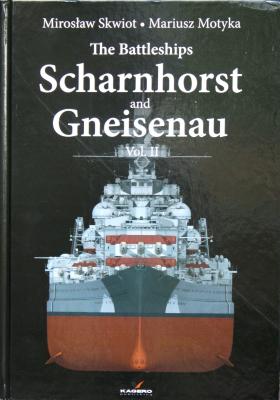The Battleships Scharnhorst and Gneisenau. Vol. II

Bottom Line
Volume 2 of the WW2 German Kriegsmarine battleships Scharnhorst and Gneisenau focuses on the career and appearance of DKM Gneisenau. Volume I gives more info on Gneisenau than anything previous – an extensive narrative history along with many B&W photos, a section of high-quality, large-scale photographs, stunning 3D graphic “visualizations” of her various fits, two large foldout sheets of 1/200 line drawings (four sides), a foldout sheet in 1/72 scale for the floatplanes and 3D glasses for the 3D photos. A modeler and historian could not ask for better references.
Background
Kagero Publishing, from Poland, is one of the major military history publishing houses. Since 1998, when Kagero started publishing in English, over 550 titles have been produced. Topics focus on individual planes, armor and ships, along with a bevy of focused topics, such as a class of warships or an armor type. The authors are well-known for their accurate and impressive 3D graphic images (Visualizations) of warships, bringing realistic estimates of their colors and appearances to an otherwise black & white world.
Nazi Germany’s Gneisenau was named after the WW1 Imperial German Navy armored cruiser Gneisenau, which together with her sister armored cruiser Scharnhorst, disrupted trade and sank British warships off the western South American Coast in 1914 before being sunk by British battlecruisers off the Falklands afterwards. The human Gneisenau was August Wilhelm Anton, Graf Neidhardt von Gneisenau, later Field Marshall (1760-1831). His claim to fame was modernizing the Prussian Army after its defeat to Napoleon in 1806, and then helped to orchestrate the Battle of Waterloo as Blucher’s Chief of Staff. He partnered with GJD von Scharnhorst, same as their warship namesakes. His strategy and tactics inspired Claus von Clausewitz’s On War classic treatise on modern warfare taught to this day in military academies.
What You Get
MSRP is $69.95, a rather steep price for a book concerning a single warship, but the wealth of info, many modeling opportunities and constant intense interest in this ship makes this price a bargain. Everything you always wanted to know about the DKM Gneisenau but were not afraid to ask! The hardbound book is a thick (28 mm or 1 1/8 inch) with 340 pages in European A4 size (210 X 296 mm or about 8 ¼ by 11 5/8 inches) with a gloss front and rear cover.
Six Chapters cover: 1) Operational service of Gneisenau; 2) Markings and camouflage; 3) Photographs specifically of Gneisenau; 4) Six stereoscopic photos and 3D glasses to see them properly; 5) Many 3D Visualizations (CG) of Gneisenau in each of its fits; and 6) Scale drawings and 3D visualizations of fittings. The mountain of detail is almost overwhelming, but Vol. II ends up being the go-to reference for exact appearances of Gneisenau, including her role as a blockship in Gdynia (now in Poland) in 1945. The authors own and still find pieces in their native Poland of Gneisenau, from her last resting place. The Author’s Note at the beginning of the book lamented that they could not do justice to show more photographs to truly show what life was like on the Gneisenau, due to the publisher citing cost reasons.
Chapter 1 fills pages 7-36 with 51 photos, 4 maps, and several pages of Admiral Lutjen’s logbook from her time in Brest bombed by British aircraft. How and why the Gneisenau was constructed, her new “Atlantic” bow, her escapes in Norway, the Atlantic raids, and the English Channel run back to Germany, her fatal bombing during conversion to replace her 11in triple turrets with 15in twin turrets, and her being towed around eventually to Gydnia where she was sunk to block the harbor form use by the Russians illustrate her stunning victories and crushing defeat.
Chapter 2 (pages 37-58) details the appearances of Gneisenau, and all of her various camouflage and colored turret guises, which should end speculation on these topics. 46 Photos included some for Scharnhorst’s camouflage after Gneisenau was permanently out of action. The last four pages follow the fate of each individual Arado Ar196 floatplane, the majority of which were trashed by her own gunfire.
Chapter 3 is the actual Photograph Gallery, from page 59-128 with 134 B&W photos of her career. These will perk up any modeler building the Gneisenau. Most are excellent quality, but interestingly, the insides of the ship are not portrayed.
Chapter 4 (pages 129-131) have six fuzzy, red and blue photographs that do show a 3D effect with the accompanying glasses
Chapter 5 holds the 3D “Visualizations” (what we call 3D graphics) for Gneisenau in full color (pages 132-217). Her appearance in mid-1940, January 1941 Berlin operation, March 6, 1941 Berlin operation, and March, 1941 in French ports, in 147 color plates from pages 132-217, ranging in size from both facing pages to 6 per page. Every exterior detail is illustrated. Her appearance in 3D graphics after mid-1941 is not shown.
Chapter 6 switches to B&W line drawings in with 3D graphics in color of different parts of Gneisenau from pages 218-339 (the rest of the book). Everything from the bridge structure to individual fittings (funnel, directors, turrets, hatches, windows, portholes, cranes, grates, ventilation covers, liferafts, boats, posts, lockers, catapult, and floatplanes) is depicted in different scales.
The two large foldout B&W line drawings in 1/200 scale are perfect for the new 1/200 scale models of Scharnhorst and Gneisenau, and also for other scales. They are a major feature of this book, as are the 1/72 foldout line drawings for the Arado Ar-196 aircraft versions in 1/72 scale. Heinkel He-60 floatplanes carried from 1934-1939 are not illustrated.
I have not seen Volume I reviewed on the IPMS Review website so I can only assume that Vol. I mostly concerns Scharnhorst. Volume II is focused on the Gneisenau. The amount of overlap is not known at present, but Vol. II is very specific about what happened to the Gneisenau and not focused on the Scharnhorst. Early in WW2, these two ships were inseparable, and nicknamed Salmon and Gluckstein by the Brits. Of course, they participated together for over two years in several campaigns, and although focused on Gneisenau, you also know what happened to Scharnhorst when they operated together.
Summary
Volume II, although pricey, is an ultimate reference for knowing about and modeling the German battlecruiser Gneisenau. The differences between Scharnhorst and Gneisenau were minor, but distinct, which makes this Volume useful. It is an impressive tour de force of research and thoroughly covers accurate appearances of wartime Gneisenau and all its external details in photos and 3D graphics. Some coverage of Gneisenau’s proposed appearance after receiving 15 inch main turrets would have made this book close to perfection. Very highly recommended for German WW2 naval enthusiasts, battleship (battlecruiser) geeks, and to accurize any of the Gneisenau models available, especially in 1/200 scale.
Figures
- Figure 1: Front Cover of The Battleships Scharnhorst and Gneisenau. Vol. II from Kagero Publishing, from Casemate Publishers.
- Figure 2: Rear cover of The Battleships Scharnhorst and Gneisenau. Vol. II.
- Figure 3: One of the four pages (Sheet B2) of the two large foldouts with line drawings in 1/200 scale of the Gneisenau.
- Figure 4: The first page (p. 132) of the 3D Visualizations (graphics) showing port, starboard and overhead views in full color of Gneisenau in mid-1940 with her Norwegian camouflage after the torpedo damage from HMS Clyde.
- Figure 5: Port, starboard and overhead 3D graphic views in full color of Gneisenau’s camouflage pattern during Operation Berlin in January 1941 (p. 147).
- Figure 6: An example of the numerous close-ups of ship sections in color – this is the rear part of the port aft superstructure, giving an idea of the detail and accuracy of the 3D images, very useful for modelers.
- Figure 7: Close-up views of the twin 105mm AA gun mount carried by Gneisenau in exquisite color detail.
- Figure 8: Photograph of the 1940 torpedo damage by HMS Clyde to Gneisenau’s newly see-thru bow.
- Figure 9: Aerial reconnaissance photograph of Gneisenau in drydock at Gotenhafen in May 1943 showing covered, empty main turret barbettes awaiting the never-installed 15in turrets and the missing bow after British bomber attacks.
Reviewer Bio
Luke R. Bucci, PhD
Luke built all kinds of models starting in the early '60s, but school, wife Naniece, and work (PhD Clinical Nutritionist) caused the usual absence from building. Picked up modeling to decompress from grad school, joined IPMSUSA in 1994 and focused on solely 1/700 warships (waterline!) and still do. I like to upgrade and kitbash the old kits and semi-accurize them, and even scratchbuild a few. Joined the Reviewer Corps to expand my horizon, especially the books nobody wants to review - have learned a lot that way. Shout out to Salt Lake and Reno IPMSUSA clubs - they're both fine, fun groups and better modelers than I, which is another way to learn. Other hobbies are: yes, dear; playing electric bass and playing with the canine kids.









Comments
Add new comment
This site is protected by reCAPTCHA and the Google Privacy Policy and Terms of Service apply.